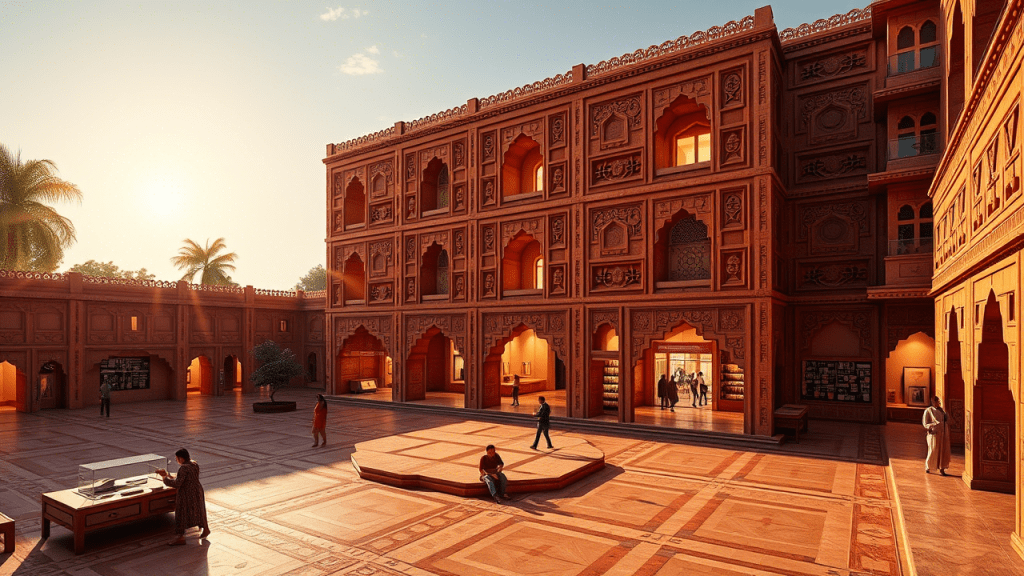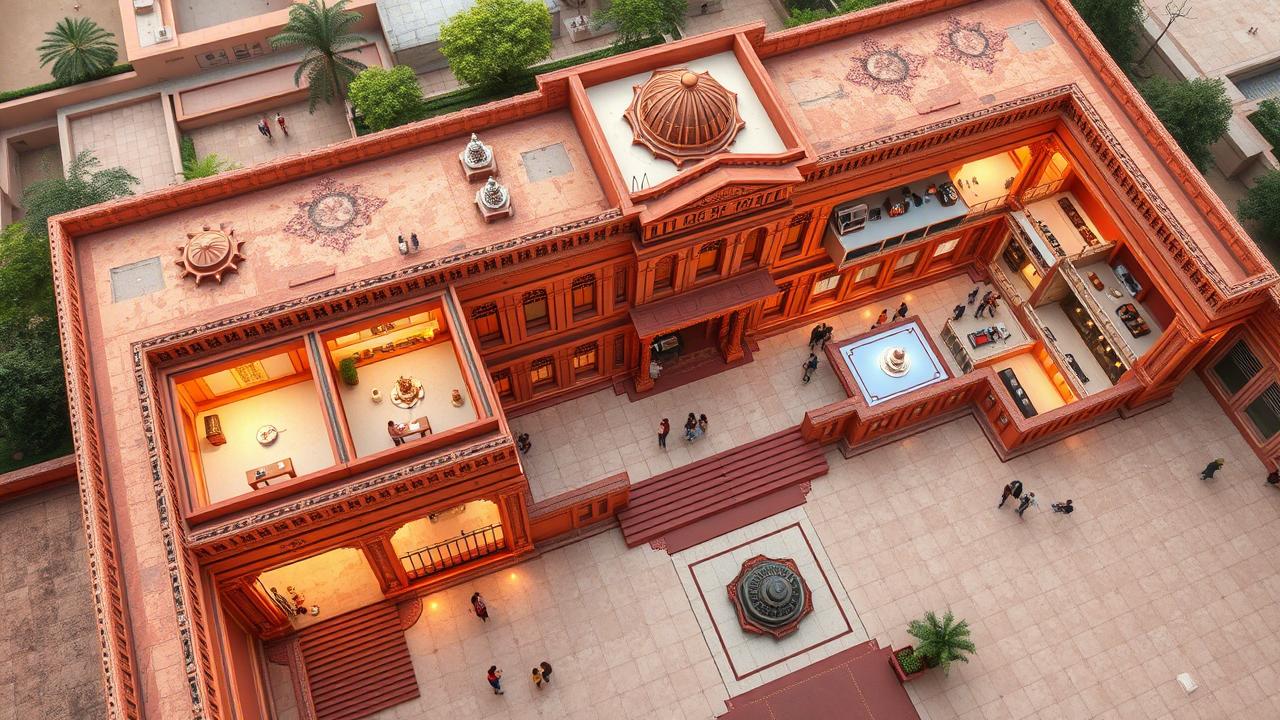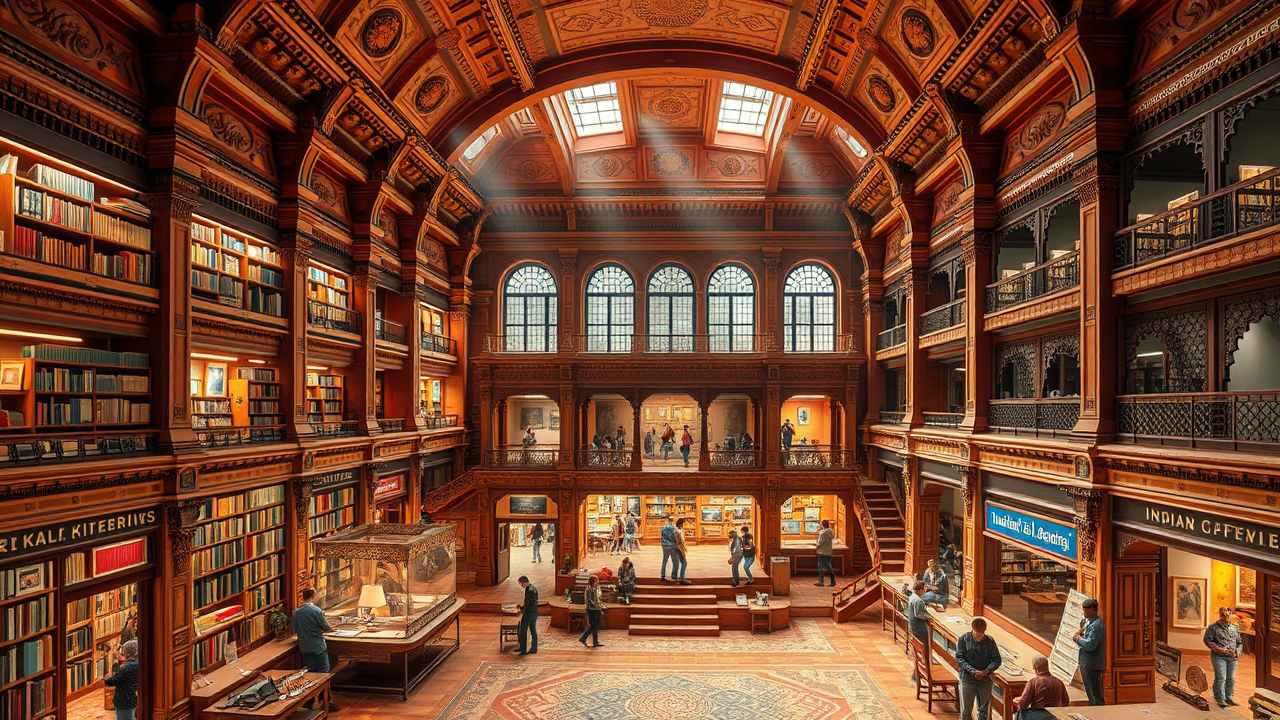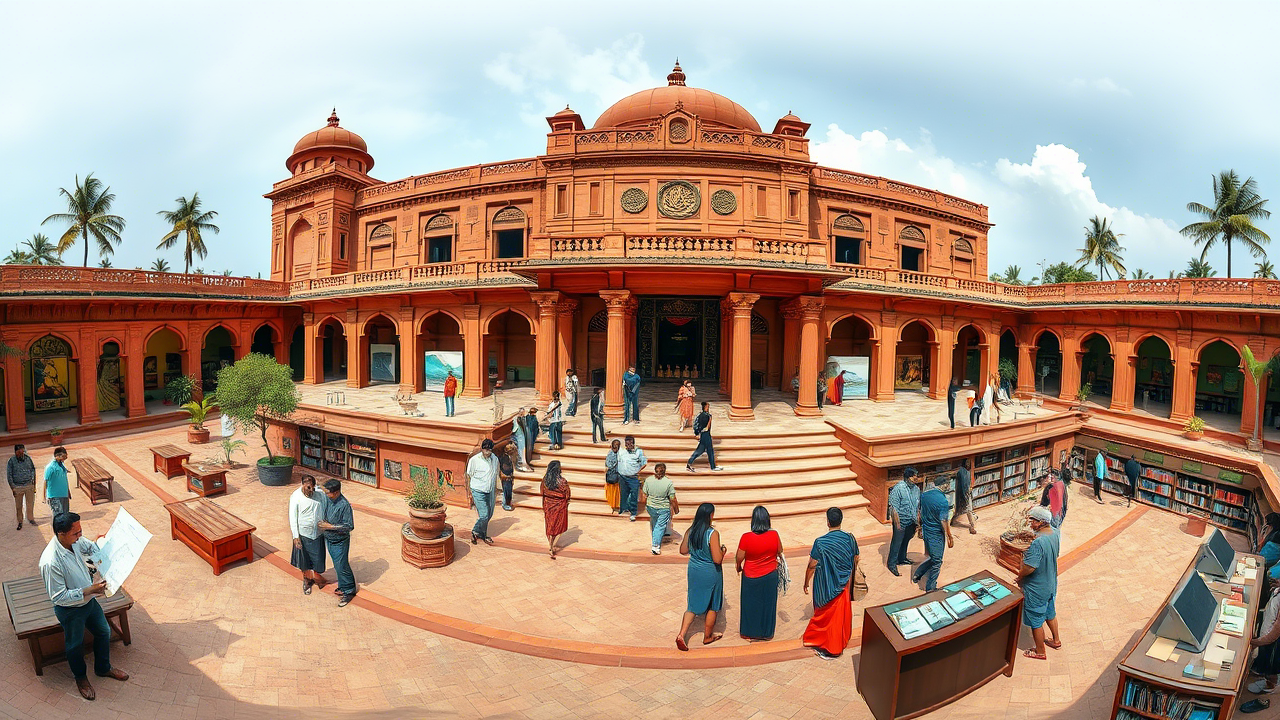- Private car and driver in Delhi / India
- +91-8447445445
- info@discoverindiabycar.com sugar.ankit@yahoo.com
 +91-9818434712
+91-9818434712
Jawahar Kala Kendra: Jaipur’s Architectural Gem & Cultural Heart | Visitor’s Guide

Jaipur. You think forts, palaces, maybe the swirl of colourful fabrics in a bazaar, right? Classic Pink City stuff. But hang on – there’s another side to Jaipur, a contemporary pulse that beats strong, and you’ll find its epicentre at Jawahar Kala Kendra (JKK).
If you’re itching to see where ancient Indian thought gets a seriously cool modern twist, and where art isn’t just displayed but truly lived, then you need to get yourself to Jawahar Kala Kendra. Forget stuffy museums for a second. This place breathes.
It’s an idea made real, a space designed to keep the arts – from Rajasthan, across India, and even globally – buzzing and alive. Trust me, after writing about cultural hotspots for over 15 years, Jawahar Kala Kendra has this unique pull; it’s where deep philosophy met brilliant design, and something special was born.
So, let’s ditch the usual script and really get under the skin of Jawahar Kala Kendra. This isn’t just a checklist; think of it as a backstage pass to understanding its design, its vibe, and why it’s become such a non-negotiable stop for anyone wanting to grasp Jaipur’s modern cultural identity.
How Did Jawahar Kala Kendra Even Happen? The Backstory
So, where did this striking place come from? Picture Rajasthan back in the late 80s. The state government had a vision, something bigger than just another monument. They wanted to honour Pandit Jawaharlal Nehru, India’s first PM – a guy known for loving culture but also championing science and clear thinking.
The big idea? Not just a building, but a multi-arts powerhouse. A place for people, reflecting those cultural hubs Nehru himself was keen on. The commission went out in ’86, construction kicked off, and by ’91, Jawahar Kala Kendra threw open its doors.
The mission was clear: give artists, craftspeople, thinkers, and frankly, anyone interested, a vibrant space to connect with arts and crafts. It was built to be dynamic, to spark conversations – and boy, does it still deliver on that today.
Architecture That Isn’t Just Seen, It’s Felt: Correa’s Genius at Jawahar Kala Kendra
Okay, let’s talk about the building, because honestly, it’s the main event at Jawahar Kala Kendra. This is the handiwork of Charles Correa, a true giant of Indian architecture. Correa wasn’t just about making things look good; his buildings belonged.
They responded to the climate, the local culture, the very ground they stood on. For JKK, he did something fascinating. He looked at Jaipur’s own origin story – its city plan, famously modelled on the ancient Vedic map of the cosmos, the Vastu Purusha Mandala.
Think of this mandala like a spiritual blueprint, often a nine-square grid, each square representing a planet (Navagraha) and its cosmic energy. Correa brilliantly adapted this ancient grid for Jawahar Kala Kendra. The entire complex? It’s laid out like that nine-square plan.
Each block isn’t just a room; it carries the symbolism of a planet, dictating its function. It genuinely feels like stepping into a mini-universe built specifically for creativity.

Cracking the Code: The Nine Squares of Jawahar Kala Kendra
How does this cosmic grid translate on the ground? Correa mapped it out cleverly:
- The Knowledge Hub (Jupiter): Where else for wisdom? The library sits under Jupiter’s influence, packed with books on art, culture, design. Your quiet corner.
- Guardians of Heritage (Mars & Mercury): This is where Jawahar Kala Kendra holds its treasures. You’ve got the Alankar Museum – pure Rajasthani folk art magic. Then there’s the Gyan Museum, often hosting really interesting temporary shows. Preservation happens here.
- The Engine Room (Sun): Makes sense, right? The admin offices, the operational heart, sit under the Sun’s energy.
- Fueling Body & Soul (Moon): The Moon means nurturing, so here lie the cafeteria and guest spots. And that Indian Coffee House? It’s practically a JKK institution, always humming.
- Where Stories Unfold (Venus): Venus governs the arts, so naturally, the performance spaces are here. Jawahar Kala Kendra gives you options: the bigger Rangayan theatre, the cosy Krishnayan for intimate events, and the awesome Open-Air Theatre using the central courtyard.
- Art’s Mystique (Rahu & Ketu): The main art galleries – Parijat I & II, Surekh, Sukriti – are linked to the shadow planets. Fitting, really. Visual art often plays with what’s real, what’s perceived. This is where you find paintings, sculptures, photos, the works.
- Where Things Get Made (Saturn): Saturn’s about discipline, craft. So, the workshops and studios, where people are actually painting, potting, printing – that’s Saturn’s domain.
And here’s a touch of pure brilliance: Correa deliberately offset one square, just like in Jaipur’s original plan where a hill got in the way. At Jawahar Kala Kendra, this shift creates the angled entrance, subtly welcoming you in. And the absolute centre, the Brahmasthan (the source point in Vedic thought)? Left open to the sky. This central courtyard, Madhyavarti, becomes this powerful, breathing space – for gatherings, for performances, just to be.
More Than Just Walls: The Vibe
The choice of local red sandstone wasn’t just practical; it instantly screams ‘Jaipur’. It connects Jawahar Kala Kendra visually and emotionally to the city. The walls feel solid, almost ancient, but they’re punctuated by these cool openings and symbols hinting at the cosmic plan.
Step inside, though, and it’s a different world. You wander through interconnected courtyards, find shade under walkways. Light does incredible things here – filtering, bouncing, creating patterns that change through the day. It’s natural air-conditioning and a visual feast rolled into one.
The whole layout invites you to meander, to explore, to discover. You don’t just observe this building; you move with it. The architecture itself is an active participant in your experience at Jawahar Kala Kendra.

So, What’s Actually Happening Inside Jawahar Kala Kendra?
Right, the building’s amazing. But what’s the actual buzz inside Jawahar Kala Kendra? This place earns its name ‘Kendra’ (centre). It’s alive. Here’s a taste:
- Museum Dives: Get lost in Rajasthan’s culture at the Alankar Museum – textiles, jewellery, everyday objects with stories. And keep an eye on the Gyan Museum for temporary shows bringing global art chats to Jaipur.
- Gallery Hopping: JKK is huge for art lovers in Jaipur. The galleries (Parijat, Surekh, Sukriti) have a constantly changing menu of exhibitions. Traditional, contemporary, photography, installation – it’s all here. Pro tip: check their website before you go!
- Stage Magic: Classical dance that’ll mesmerize you, music that hits the soul, theatre that makes you think, folk performances bursting with energy – the stages at Jawahar Kala Kendra host it all. Catching a show is like plugging directly into India’s performing arts scene.
- Bookworm Corner: The library’s a peaceful escape. Perfect for researchers, students, or just anyone wanting quiet time with books on art and culture.
- Get Your Hands Dirty: Fancy trying block printing? Pottery? Maybe some acting exercises? Jawahar Kala Kendra runs workshops all the time, for all sorts of people. It’s a brilliant way to connect with creativity directly.
- Meet the Makers at Shilpgram: Often buzzing right next door, Shilpgram is where artisans sell their work, especially during craft fairs (melas). Great spot to buy unique, handmade stuff straight from the source.
- That Coffee House: Seriously, you haven’t done JKK right if you haven’t chilled at the Indian Coffee House. Cheap coffee, simple snacks, and an atmosphere buzzing with students, artists, thinkers – it’s legendary for a reason. A must-do within Jawahar Kala Kendra.
Feel the Beat: Events, Festivals, and the JKK Vibe
What really makes Jawahar Kala Kendra tick is that it’s never static. It’s always got something cooking. Think festivals, special events, talks, film nights, cultural jams – the calendar’s packed.
- Big Ticket Events: Keep an ear out for their major annual gigs – Jaipur Art Summit, theatre festivals, classical music events, big craft bazaars. They often pull in talent and crowds from all over.
- The Everyday Hum: Even on a random Tuesday, chances are something’s happening – a gallery opening, a workshop humming along, artists deep in conversation. This constant low-level energy gives Jawahar Kala Kendra its unique charge.
- Creative Crossroads: It’s just naturally where Jaipur’s arty folks gather. Writers, painters, musicians – you’ll find them hanging out here. It’s a great place to tap into the city’s creative undercurrent.

Is Jawahar Kala Kendra Your Scene?
So, who should make a beeline for this place? I reckon Jawahar Kala Kendra clicks with a lot of different people:
- Architecture Geeks: Oh yeah. Seeing Correa’s ideas in the flesh, that mix of modernism and ancient Vedic concepts? Mind-blowing.
- Art Addicts: The galleries serve up a fantastic slice of Rajasthani tradition and cutting-edge Indian contemporary art. You might find your next obsession here.
- Culture Buffs: Want real Indian performing arts? Fancy learning a craft? Or just want to soak up a genuinely creative atmosphere? JKK is calling.
- Curious Minds: The library, the talks, the seminars – plenty to feed your brain.
- Travellers Craving Depth: Look beyond the usual tourist circuit. Jawahar Kala Kendra shows you Jaipur’s living, breathing cultural side.
- Anyone Needing a Spark: Honestly? The combination of smart design, human creativity, and just interesting people milling about… it’s inspiring stuff.

The Nitty-Gritty: Planning Your Jawahar Kala Kendra Visit
- Finding It: Super easy. Jawahar Kala Kendra is right on Jawaharlal Nehru Marg (JLN Marg), near Rajasthan University. Can’t miss it.
- When to Swing By: General hours are roughly 10 AM to 6 PM, but often later if there’s an evening show. Galleries/museums usually run 11 AM to 6 PM. The Coffee House might do its own thing. Best advice? Always, always check the official Jawahar Kala Kendra website or their social media for the latest times before you rock up. Especially crucial for specific shows. Remember, it’s usually shut on Mondays and major holidays.
- Paying Your Way: Expect a small fee for the museums and galleries inside Jawahar Kala Kendra. Tickets for plays, concerts, workshops are sold separately and vary. Sometimes just wandering the courtyards or hitting the coffee shop is free.
- Getting There: Autos, Uber/Ola, regular taxis – all easy options. Local buses cruising down JLN Marg work too.
- Making it Count:
- Don’t Rush: Give it a solid 2-3 hours minimum just to wander and soak it in. More if you’re seeing a show or really exploring an exhibit at Jawahar Kala Kendra.
- Check What’s On: Seriously, a 2-minute website check could mean catching something amazing.
- Happy Feet = Happy Explorer: You’ll walk. Wear comfy shoes.
- Hydration Station: Jaipur gets hot. Bring water.
- Good Vibes Only: It’s a cultural place. Keep it chill in galleries/library, phones silent during shows.
- Photo Ops: Snapping pics in courtyards? Usually fine. Inside galleries or during performances? Probably not. Always best to check.

Quick FAQs: Your Jawahar Kala Kendra Cheat Sheet
Q1. What’s the big deal about Jawahar Kala Kendra?
A. Two main things: First, its absolutely unique architecture by Charles Correa, based on ancient Vedic cosmology (Vastu Purusha Mandala). Second, it’s a super important multi-arts hub in Jaipur, constantly buzzing with Jawahar Kala Kendra-hosted art shows, theatre, music, workshops, blending heritage and contemporary vibes.
Q2. Who designed Jawahar Kala Kendra?
A. The legendary Indian architect Charles Correa designed Jawahar Kala Kendra. He brilliantly merged modern design with the traditional Navagraha (nine planet) mandala concept.
Q3. Do you have to pay to get into Jawahar Kala Kendra?
A. Usually, yes – a small entry fee for the museum and art gallery sections of Jawahar Kala Kendra. Tickets for specific performances, workshops, or festival events cost extra. You might get into the courtyards or coffee shop for free.
Q4. What is there to actually do there?
A. Heaps! Check out the amazing building, browse art (traditional & modern), explore the Rajasthani craft museum, catch live performances, hit the library, maybe join a workshop, grab coffee at the iconic Indian Coffee House, and just soak up the creative energy that is Jawahar Kala Kendra.
Q5. Best time of year to visit Jawahar Kala Kendra?
A. Weather-wise, October to March is prime time in Jaipur, making it comfy for visiting Jawahar Kala Kendra. For specific festivals, check their annual calendar. Aim for gallery hours (usually 11 AM – 6 PM) to see the main stuff.
Q6. How long should I plan for my visit?
A. Give yourself 2-3 hours minimum just to walk around and get a feel for it. If you’re seeing a show, doing a workshop, or really diving into an exhibition at Jawahar Kala Kendra, you’ll need way more time.
The Final Word: Why Jawahar Kala Kendra Sticks With You
Look, Jawahar Kala Kendra isn’t just another spot on the tourist map. It’s bigger than that. It’s an idea made tangible – a place where India’s ancient philosophical roots feed its vibrant, modern creative scene. Charles Correa didn’t just build walls; he shaped an environment that boosts the cultural life within it. It’s a living tribute to Nehru’s vision and a crucial engine for art and ideas in Rajasthan.
Whether architecture pulls you in, art is your jam, or you’re just hunting for a spot that feels both calm and buzzing with possibility, Jawahar Kala Kendra delivers. It asks you to slow down, look closer, maybe even get involved. A visit here isn’t just sightseeing; it’s tapping into the contemporary cultural heartbeat of Jaipur. That makes Jawahar Kala Kendra an experience that genuinely resonates.











